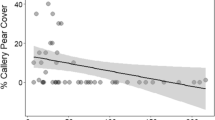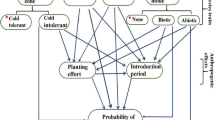Abstract
Climbing vines cause substantial ecological and economic harm, and are disproportionately represented among invasive plant species. Thus, the ability to identify likely vine invaders would enhance the effectiveness of both prevention and management. We tested whether the Weed Risk Assessment (WRA) accurately predicted the current invasion status of 84 non-native climbing vines in Florida. Seventeen percent of the species require further evaluation before risk of invasion can be determined. Of the remaining 70 species, the WRA predicted that 70% were at high risk for invasion, but only 50% of the 84 species are currently invasive in Florida. The status and risk prediction were inconsistent for 27% of the species: 15 non-invaders were predicted to be of high risk for invasion (i.e., false positive) and 4 invaders were predicted to be of low risk (i.e., false negative). Longer residence time in the flora was significantly correlated with higher invasion risk. Further investigation is necessary to identify whether residence time explains inconsistencies between risk and status conclusions, or whether the WRA over-predicts invasion risk. Nevertheless, the effects of invasive vines on native systems coupled with the influence of time on invasion status, suggest a precautionary approach is warranted when considering the introduction and management of non-native vines.

Similar content being viewed by others
References
Batianoff GN, Butler DW (2003) Impact assessment and analysis of sixty-six priority invasive weeds in south-east Queensland. Plant Prot Q 18:11–17
Caley P, Kuhnert PM (2006) Application and evaluation of classification trees for screening unwanted plants. Austral Ecol 31:647–655
Castro SA, Figueroa JA, Muñoz-Schick M, Jaksic F (2005) Minimum residence time, biogeographical origin, and life cycle as determinants of the geographical extent of naturalized plants in continental Chile. Divers Distrib 11:183–191
Champion PD, Clayton JS (2001) A weed risk assessment model for aquatic weeds in New Zealand. In: Groves RH, Panetta FD, Virtue JG (eds) weed risk assessment. CSIRO Publishing, Victoria, pp 194–202
Chong KY, Corlett RT, Yeo DCJ, Tan HTW (2011) Towards a global database of weed risk assessments: a test of transferability for the tropics. Biol Invasions 13:1571–1577
Colunga-Garcia M, Haack R, Magarey R, Borchert D (2013) Understanding trade pathways to target biosecurity surveillance. NeoBiota 18:103–118
Daehler CC (1998) The taxonomic distribution of invasive angiosperm plants: ecological insights and comparison to agricultural weeds. Biol Conser 84:167–180
Daehler CC, Denslow JL, Ansari S, Kuo H (2004) A risk assessment system for screening out harmful invasive pest plants from Hawaii’s and other Pacific islands. Conserv Biol 18:360–368
DeLong ER, DeLong DM, Clarke-Pearson DL (1988) Comparing the areas under two or more correlated receiver operating characteristic curves: a nonparametric approach. Biometrics 44:837–845
Dlugosch KM, Parker IM (2008) Founding events in species invasions: genetic variation, adaptive evolution, and the role of multiple introductions. Mol Ecol 7:431–449
Ewel JJ (1986) Invasibility: lessons from South Florida. In: Mooney HA, Drake JA (eds) Ecology of biological invasions of North America and Hawaii. Springer, New York, pp 214–230
Genton BJ, Shykoff JA, Giraud T (2005) High genetic diversity in French invasive populations of common ragweed, Ambrosia artemisiifolia, as a result of multiple sources of introduction. Mol Ecol 14:4275–4285
Gordon DR (1998) Effects of invasive, non-indigenous plant species in ecosystem processes: lessons from Florida. Ecol Appl 8:975–989
Gordon DR, Onderdonk DA, Fox AM, Stocker RK (2008a) Consistent accuracy of the Australian Weed Risk Assessment system across varied geographies. Divers Distrib 14:234–242
Gordon DR, Onderdonk DA, Fox AM, Stocker RK, Gantz C (2008b) Predicting Invasive Plants in Florida using the Australian Weed Risk Assessment. Invasive Plant Sci Manage 1:178–195
Gordon DR, Mitterdorfer B, Pheloung PC, Ansari S, Buddenhagen C, Chimera C, Daehler CC, Dawson W, Denslow JS, LaRosa A, Nishida T, Onderdonk DA, Panetta FD, Pyšek P, Randall RP, Richardson DM, Tshidada NJ, Virtue JG, Williams PA (2010) Guidance for addressing the Australian Weed Risk Assessment questions. Plant Prot Q 25(2):56–74
Gordon DR, Gantz CA, Jerde CL, Chadderton WL, Keller RP, Champion PD (2012) Weed risk assessment for aquatic plants: modification of a New Zealand system for the United States. PLoS ONE 7(7):e40031. doi:10.1371/journal.pone.0040031
Harris CJ, Murray BR, Hose GC, Hamilton MA (2007) Introduction history and invasion success in exotic vines introduced to Australia. Divers Distrib 13:467–475
Hellmann JJ, Byers JE, Bierwagen G, Dukes JS (2008) Five potential consequences of climate change for invasive species. Conserv Biol 22:534–543
Horvitz CC, Pascarella JB, McMann S, Freedman A, Hofstetter RH (1998) Functional roles of invasive non-indigenous plants in hurricane-affected subtropical hardwood forests. Ecol Appl 8:947–974
Kearns SK (2008) Nonnative terrestrial species invasions. In: Waller DM, Rooney TP (eds) The Vanishing Present: Wisconsin’s changing lands, waters, and wildlife. University of Chicago Press, Chicago, pp 439–452
Landis JR, Koch GG (1977) The measurement of observer agreement for categorical data. Biometrics 33:159–174
Lieurance D, Flory SL, Cooper AL, Gordon DR, Fox AM, Dusky J, Tyson L (2013) The UF/IFAS assessment of nonnative plants in Florida’s natural areas: History, purpose, and use. University of Florida IFAS Extension SS-AGR-371
Lockwood JL, Cassey P, Blackburn T (2005) The role of propagule pressure in explaining species invasions. Trends Ecol Evol 20:223–228
Lonsdale WM (1999) Global patterns of plant invasion and the concept of invasibility. Ecology 80:1522–1536
Novy A, Flory SL, Hartman JM (2013) Evidence for rapid evolution of phenology in an invasive grass. J Evol Biol 26:443–450
Pemberton RW, Liu H (2009) Marketing time predicts naturalization of horticultural plants. Ecology 90:69–80
Perrings C, Williamson M, Barbier EB, Delfino D, Dalmazzone S, Shogren J, Simmons P, Watkinson A (2002) Biological invasion risks and the public good: an economic perspective. Conserv Ecol (1):1 http://www.consecol.org/vol6/iss1/art1. Accessed 6 June 2016
Pheloung PC, Williams PA, Halloy SR (1999) A weed risk assessment model for use as a biosecurity tool evaluating plant introductions. J Environ Manag 57:239–251
Pimentel D, Zuniga R, Morrison D (2005) Update on the environmental and economic costs associated with alien-invasive species in the United States. Ecol Econ 52:273–288
Plant Health Program (2005) Plant protection and quarantine strategic plan FY005-2009. U.S. Department of Agriculture, Riverdale, Maryland
Pyšek P, Křivánek M, Jarošík V (2009) Planting intensity, residence time, and species traits determine invasion success of alien woody species. Ecology 90:2734–2744
Rejmánek M, Pitcairn MJ (2002) When is eradication of exotic pest plants a realistic goal? In: Veitch CR, Clout MN (eds) Turning the tide: the eradication of invasive species. IUCN Gland, Cambridge, pp 249–253
Richardson DM, Pyšek P (2006) Plant invasions: merging the concepts of species invasiveness and community invasibility. Prog Phys Geog 30:409–431
Schnitzer SA, Bongers F (2011) Increasing liana abundance and biomass in tropical forests: emerging patterns and putative mechanisms. Ecol Lett 14:397–406
Simberloff D (1997) The biology of invasions. In: Simberloff D, Schmitz DC, Brown TC (eds) Strangers in paradise: impact and management of nonindigenous species in Florida. Island Press, Washington, pp 3–17
US Congress (1993) Harmful non-indigenous species in the United States. Washington, DC: US Congress, Office of Technology Assessment, OTA-F-565
Wilson JRU, Richardson DM, Rouget M, Proches S, Amis MA, Henderson L, Thuiller W (2007) Residence time and potential range: crucial considerations in modelling plant invasions. Divers Distrib 13:11–22
Acknowledgements
We thank Austin Young and Christina Wiley for conducting WRA assessments and two reviewers for helpful comments. DRG was supported by gifts to the Environmental Defense Fund from the Kravis Scientific Research Fund and Robertson Foundation. Funding for the UF/IFAS Assessment of Non-native Plants in Florida’s Natural Areas is provided in part by the UF/IFAS Deans for Research and Extension and the Florida Fish and Wildlife Conservation Commission.
Author information
Authors and Affiliations
Corresponding author
Rights and permissions
About this article
Cite this article
Gordon, D.R., Lieurance, D. & Flory, S.L. Predicted versus actual invasiveness of climbing vines in Florida. Biol Invasions 19, 2375–2384 (2017). https://doi.org/10.1007/s10530-017-1448-7
Received:
Accepted:
Published:
Issue Date:
DOI: https://doi.org/10.1007/s10530-017-1448-7




